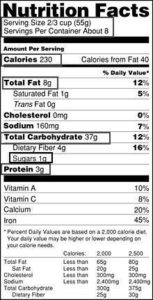Grocery Shopping: From No Fun to Easily Done- Part II
 By: Emily Parsons, Pn1
By: Emily Parsons, Pn1Nutritionist
SPECTRUM, Inc
Fear not, Part II of your guide to grocery shopping is here! I know I know, you’ve been on pins and needles waiting for this to come out, thinking ‘I know how to prep and plan now, but what in the world do I do when I get to the store?’ Don’t worry- I’ve got it covered for you.
As a reminder, in Part I we tackled the prepping and planning side of grocery shopping including creating rituals, making lists, setting budgets and choosing the right store for you. This time around we are digging in to the nitty-gritty details of getting around the store including:
1. Navigating the Store
2. Analyzing Ingredients
3. Debunking Labels
So make sure you’ve got your planning and prepping taken care of because I know you’ll be itching to hit your store of choice after breezing through these tips and tricks.
NAVIGATING THE STORE
First and foremost, you’ve heard it before and you’ll hear it again- don’t go to the store hungry. I can say from personal experience (and I bet you can too) that shopping on an empty stomach can lead to some slightly unplanned choices. Suddenly you remember how perfectly seasoned and crunchy those kettle cooked potato chips are; you swear the chocolate chips in the cookies have turned into little eyes that are staring you down, begging to be picked up; and the 2 for $5 Ben & Jerry’s is the clearest sign of destiny you could possibly imagine. You know what I’m saying. So instead of wrecking your plan and budget, eat a snack (preferably with a mix of protein and fruit/veg).
Alright, so now that you are well fed, your next task is to avoid the strategically planned sales and end caps. Don’t get me wrong, I’m all for a great sale and saving some dineros. However, more often than not, the BOGO deals are for items that probably weren’t on your list to begin with (like packaged chips, cookies and snacks). So feel free to give them a quick glance, but don’t get tricked into thinking you are saving if it wasn’t something you were planning on getting in the first place.
Now you’re in- well fed and sale blinders up…so where to now? Well, remember to stick to your budget priorities we went over last time (proteins→produce→staple items) and be strategic with your purchases. Does the item you’re after have a long shelf life (i.e. grains, spices, canned beans, frozen fruits)? Then, save some time and money by going for the bulk purchase. That being said don’t be afraid of all canned and frozen items. Frozen fruits and veggies are a great option (usually picked at the peak of their season), and canned beans and some (low-sodium) soups and veggies are okay picks too.
Bonus tip: When you’re grabbing something in an aisle, try entering and exiting the same way to avoid any extra eye-catching temptations. The vast majority of nutrient-dense whole foods are located outside of the aisles.
OUTSMARTING THE PACKAGING
There is a big problem with modern day grocery stores and packaged foods: consumers are consistently being duped by clever marketing. While we would like to believe that every company has consumer health as their top priority, the reality is that profits and bottom-line thinking often takes precedence. If a company can claim their product is ‘all-natural,’ ‘heart-healthy,’ or ‘high-fiber’ to help improve sales, that also has to mean it’s a healthy option…right?
Well consider this, the American Heart Association has actually endorsed Cocoa Puffs cereal, canned soup that solely exceeds the daily sodium intake recommendation, and fruit juice with more than 40g of sugar per serving. And as for those ‘high fiber’ packaged foods, many times manufacturers have to add fiber back into their processed foods from sources like wood pulp or highly processed plant roots after they strip all of the naturally occurring fiber out during processing. (Check out this article for more info).
Still convinced these claims actually mean ‘healthy’? Maybe not. In reality, the more a food has to convince you that it’s good for you, the more skeptical you should be.
So, if we can’t go off front-of-package nutritional claims alone, how should we be deciding what ‘healthy’ actually means? It’s time to flip the package over – or, better yet, focus on buying whole foods that don’t require any packaging.
ANALYZING INGREDIENTS
Let’s play a little game.
Pick all the words that are forms of sugar: Galactose, Fructose, Maltose, Disaccharide, Glucose, High Fructose Corn Syrup, Brown Rice Syrup, Molasses, Agave, Sucrose, Polysaccharide.
If you picked them all then (unfortunately) you win- and that doesn’t even cover the whole list! And don’t even get me started on fancy names for artificial sweeteners…
The point is, fumbling through scientific jargon on ingredient lists can be frustrating at best. How are you supposed to be able to decipher good and bad if you don’t even have a clue what you’re looking at?
I’m not a scientist, but I do know that we are sicker as a society than we have ever been, and we are eating more processed packaged and fast foods than ever before. Regardless of correlation vs. causation, I believe fervently in trying to minimize artificial ingredients and having a strict no-no list to look out for when analyzing ingredients. Some examples that could go on that list includes: artificial sweeteners, artificial flavorings, artificial colors, added sugars, soy, gluten or non-organic products. Your list might be a little different than mine, but it’s important you identify the standards that are important for you to have a healthy lifestyle.
The bottom line is generally the less ingredients, the better. It starts with awareness- so next time you are at the store take an extra minute to flip over the back of packages and read through the list of ingredients. You might be surprised at what you find…
DEBUNKING LABELS
It’s probably not surprising that when surveyed, over 50% of shoppers that read nutrition labels admitted to not really knowing what they were looking at. Weird percentages, confusing serving sizes and tons of erroneous numbers can turn a well-intentioned label into a perplexing puzzle.
Allow me to simplify for you. After you read the ingredients, the main things you should be aware of are:
1. Serving Size
2. Calories
3. Total Fat
4. Total Carbs
5. Protein

First and foremost, don’t get duped by serving sizes! Companies love to put a small serving size so the nutrition label is more appealing and they can make misleading claims on the front. You may think you’re doing great with a well-balanced snack…until you realize there are 8 servings. Whoops.
Once you know the serving size, check out the calories and macronutrients. Fat, carbs and protein are the only 3 sources in your food that total calories come from, and it’s important to keep this in proper balance according to your goals (more to come on that later). *Remember, just because a food is low in calories, it doesn’t mean it’s a ‘health food’- you need vital micronutrients and phytonutrients that are packed in whole, nutrient-dense foods (especially fruits and veggies!)
Beyond these basics, a couple bonus items I’d keep an eye on are sugar and sodium. You’d be surprised how much sugar will show up in places you wouldn’t expect it (even bread can have up to 5g per slice!) The general recommendation right now is to not exceed 30g of added sugar per day (not including sugar naturally occurring in fruits and vegetables). Sodium can also get out of control in processed, packaged foods since it can act as a preservative and flavor enhancer. The goal should be to not exceed 2000mg of sodium (about 1 teaspoon) since high sodium intake can be linked to high blood pressure, stroke, and numerous chronic illnesses.
PUTTING IT ALL TOGETHER
It’s official- you’re ready to become the master grocery shopper you’ve always dreamed of. I’m officially releasing you to go forth and conquer the store of your choice. As a quick recap, here are all the steps we covered in this series:
1. Creating a Ritual
2. Making a List
3. Setting a Budget
4. Choosing a Store
5. Navigating the Store
6. Outsmarting the Packaging
7. Debunking Labels
Now it’s your job to take the next right step. If you already have the first few covered, then shift your focus to where you might be lacking. And if you need a little extra help, consider setting up a Free Nutrition Consultation at SPECTRUM- just give us a call to get it all set up (321.218.0435).
Leave a Reply